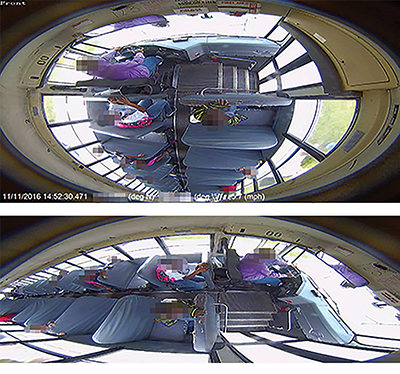
By Steven Winnefeld
The technology of 360° cameras, otherwise known as omnidirectional cameras, has been rapidly evolving over the past few years. The applications for this technology are readily apparent, coming quickly into use in photography, mapping streets and video conferences. Now this technology has matured, leading to 360° cameras with smaller, more compact enclosures that are perfect solutions for mobile mass transit surveillance problems.

Some 360° cameras are large and cumbersome, often enclosing multiple cameras that capture images that have to be “digitally stitched” together with complicated software. Now there are 360° cameras in development that make use of only one very high-resolution image sensor, and a large fisheye lens that captures a circular angle of view of 180°, or an entire “hemisphere.” This image sensor and lens can be mounted in a mobile-rated enclosure similar to how conventional mobile cameras are installed on buses today. The “warped” or fisheye image that is recorded can be simply “dewarped” with a click of a button by current video playback software such as SafetyView® PRO. The image can then be panned and viewed by dragging the mouse.
360° cameras produce a panoramic image, which is an incredibly wide angle view in one frame. This has multiple benefits when installed on a transit bus. When an event starts at the front or back of the bus and travels to the other side, you’ll need several conventional cameras to capture all of the action. In the playback software, you might have to arrange a few camera views side-by-side and pay careful attention to when objects leave one frame and enter another. With a 360° camera, all of the movement is in a continuous, single frame, never leaving your view. Simply pan the 360° image as the event unfolds and never miss anything in a blind spot.
Some buses and motorcoaches are installed with rather high seatbacks, or dividers that may obstruct certain views. The traditional method of solving this problem was simply to use more cameras, often installed low and at an angle to see around blocked views. A 360° camera is a more elegant solution – the camera is simply mounted centrally on the ceiling of the bus, producing a bird’s-eye view that lets you see down and over the tops of these high seatbacks. What was once a five or six-camera installation can be reduced to two or three well-placed 360° cameras. Higher resolution images are created at a better angle with fewer cameras, less holes drilled into the bus interior and less cables to install and maintain.
In order to generate such an expansive field of view, the image sensor in a 360° camera must produce incredible resolution to maintain detail. Mobile-rated 360° cameras should, at a minimum, record video at a resolution of at least 2K x 2K pixels. This is even greater than 1080P high definition. This extra resolution supports precise zoom capabilities to see distant objects in more detail. A 360° camera mounted in the front of the bus can capture the driver, the front seats, the farebox, the door – and you can also zoom in and witness events happening outside the door with clarity, providing comprehensive evidence of events.
Mobile-rated 360° cameras should also include powerful IR illuminators to ensure bright and clear images in low-light conditions. With all of these features combined, the video captured with 360° cameras is more comprehensive, more complete, and ultimately more useful when improving the safety of both drivers and passengers.
Steven Winnefeld is the documentation specialist for Safety Vision, LLC, a pioneer in mobile video surveillance systems. Safety Vision prides itself on its institutional knowledge. For a complete set of references please visit: http://bit.ly/1IwdQCu.
